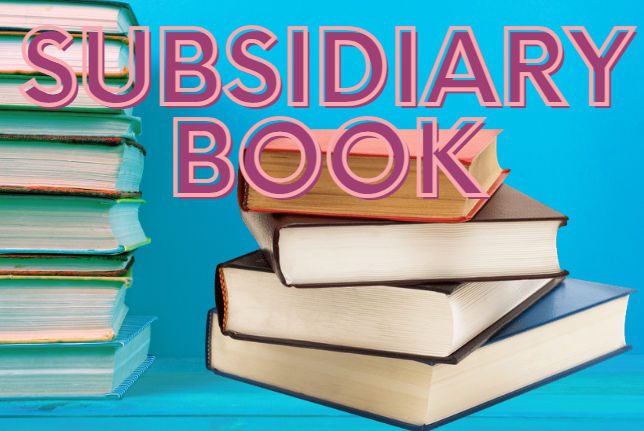Subsidiary Books Overview:
- Special accounting records in business for tracking various transaction types.
- Organize and record sales, purchases, and outstanding amounts.
Common Types of Subsidiary Books:
- Sales, purchases, bills payable, and receivable books.
- Additional books like petty cash, sales return, and debit account books.
Consideration of Special Journals:
- Special journals, such as the daybook or triple column cash book, also serve as subsidiary books.
- Provide detailed information about specific transactions.
Importance for Accurate Financial Records:
- Crucial for maintaining precise financial records.
- Facilitate ease in accounting processes.
Role in Tracking Work and Achieving Goals:
- Help businesses categorize transactions for better tracking.
- Simplify the analysis and reconciliation of financial data.
- Contribute to achieving organizational goals.
Defining Subsidiary Book in Accounting
Subsidiary Books in Accounting:
- Subsidiary books are distinct accounting records dedicated to specific transaction types, including sales of goods, purchases of goods, cash receipts for work, and payments to the firm.
- They serve as organized repositories for tracking the flow of goods and work within a company, contributing significantly to financial record-keeping.
Crucial Role in Financial Firms:
- Subsidiary books are instrumental in financial firms, aiding accountants in organizing and analyzing various aspects of a company’s finances.
- They play a pivotal role in maintaining records of goods and understanding their financial impact on the business.
Financial Record-Keeping:
- Subsidiary books are utilized to systematically record transactions related to goods, facilitating organized tracking of their flow.
- They enable businesses to categorize different types of financial information, with examples such as the sales book recording sales transactions and the purchase book documenting purchases.
- By using subsidiary books, businesses can easily locate specific accounts without cluttering the general ledger, streamlining the tracking and analysis of transactions related to accounts receivable, accounts payable, and cash flow.
Connection to Subsidiary Book of Prime Entry:
- Different subsidiary books are vital for maintaining accurate records and are linked to the main books where original entries are made.
- For instance, a purchase transaction is first recorded in the purchase journal and then transferred to the purchases ledger for tracking and analysis.
- This connection ensures the accurate recording of transactions, making it easier to keep track of financial activities and maintain precise financial records.
Exploring Types of Subsidiary Book
Sales and Purchases Book:
- The sales book is crucial for recording credit sales, detailing the date, customer name, invoice number, sale amount, and any applicable taxes or discounts.
- It aids businesses in tracking sales, analyzing revenue, and maintaining organized financial records.
- The purchases book is utilized for recording credit purchases, providing essential information for tracking expenses and managing inventory.
- Details in the purchases book include the date of purchase, supplier’s name, invoice number, quantity purchased, unit price, and total amount.
Return Books for Sales and Purchases:
- Separate books handle returns or cancellations: the sales return book documents goods returned by customers, while the purchase return book records goods returned to suppliers.
- These dedicated return books contribute to organized record-keeping and facilitate the analysis of return transactions.
Overall Significance:
- Subsidiary books, also known as separate or different books, are integral in accounting for their role in tracking specific types of transactions.
- They ensure accurate and organized record-keeping, simplifying the analysis of financial data and the preparation of financial statements.

Overview of Sales Subsidiary Book
The sales subsidiary book serves as a central record for all sales made on credit and cash sales. It contains comprehensive information such as the date of the sale, customer name, invoice number, amount of the sale (including taxes or discounts), among other relevant details.
By maintaining this detailed record in a centralized manner through the use of a sales subsidiary book (also known as a sales day book), businesses can easily access information related to their credit sales transactions.
Overview of Purchases Subsidiary Book
Purchases Subsidiary-Book:
- The purchases subsidiary-book is a dedicated record tracking all purchases made by a company, containing details such as date, supplier’s name, invoice number, quantity, unit price, and total amount.
- Maintaining a separate purchases subsidiary book ensures accurate accounting and efficient inventory management.
Return Books for Sales and Purchases:
- Separate return books are used for accurate tracking of returns: the sales return book for goods returned by customers and the purchase return book for goods returned to suppliers.
- These books aid in organized record-keeping, trend analysis of returns, and effective inventory management.
Cash and Bills Subsidiary Book:
- The Cash and Bills Subsidiary Book, also known as the Cash Book, records cash receipts, payments, bills receivable, and bills payable transactions.
- It maintains separate records for cash purchases, cash sales, bank transactions, bills receivable, and bills payable, ensuring accurate record-keeping and easy retrieval of transaction information.
Cash Book Format and Significance:
- The cash book records all cash transactions, with formats varying based on business needs. A common format is the triple column cash book, including columns for cash receipts, payments, and discounts allowed or received.
- Businesses may use a separate petty cash book for small expenses and reimbursements from a petty cash fund.
Bills Payable Book Format and Purpose:
- The bills payable book is designed to record all bills a company needs to pay to its creditors, featuring columns for date, bill number, creditor’s name, amount owed, and due date.
- This organized record ensures timely payment to creditors and accurate tracking of financial obligations.
Importance of Subsidiary Book
Role of Subsidiary Books in Financial Records:
- Subsidiary books, including the purchase book, sales book, petty cash book, bills payable book, and receivable book, are crucial for maintaining accurate and organized financial records.
- These distinct books efficiently categorize transactions, facilitating easy tracking and analysis of purchases, sales, cash inflows, and cash outflows.
Advantages in Accounting Processes:
- Subsidiary books simplify the recording of transactions, ensuring accurate and organized documentation of financial activities.
- Efficiently tracks different transaction types, making it simpler to manage accounts.
- Separation of transactions into specific books, like the bills payable book and triple column cash book, enhances the management of individual accounts, providing a clear financial overview.
- Facilitates adjustment and closing entries, offering reliable information for accurate financial reporting and proper closure of revenue and expense accounts at the end of an accounting period.
Significance for Trial Balance and Ledger:
- Subsidiary-books are of paramount importance for businesses to monitor financial activities, aiding in the preparation of accurate reports and the proper closure of accounts at the end of each accounting period.
- Contributes to the accuracy of trial balance and ledger entries, ensuring a comprehensive and reliable financial representation.
Formats of Key Subsidiary Book
Formats of Subsidiary Books:
- Subsidiary books’ formats are integral for maintaining organized and accurate transaction records in businesses.
- Subsidiary-books are distinct records designed for specific transactions, such as sales, purchases, bills payable, and bills receivable.
Purchase Book Format Application:
- The purchase book serves as a vital record for businesses to document all their purchases.
- Key details like the date, supplier’s name, invoice number, quantity, and cost of each purchase are systematically recorded in the purchase book.
- The purchase book format utilizes columns to organize essential information, providing a clear snapshot of buying activities.
- Consistent use of this format enables businesses to easily track their purchases, facilitating a comprehensive understanding of expenditure trends.
Journal Proper Usage in Subsidiary Book Accounts:
- The journal proper is a specialized book designed for recording transactions that don’t align with other dedicated books, making it useful for entries like adjustments.
- Unlike other books, the journal proper lacks a predefined format, allowing flexibility in recording various entry types.
- Correct utilization of the journal proper ensures accurate recording of all transactions within the accounting system.
- The incorporation of different book formats, such as the purchase book and journal proper, enables businesses to maintain meticulous records and organizational efficiency.
Practical Aspects of Subsidiary Book
Subsidiary-books play a crucial role in accounting by providing a systematic and organized way to record specific types of transactions. They help ensure accurate and efficient recording, making the overall accounting process smoother. Let’s explore the practical aspects of subsidiary-books and understand their importance in maintaining financial records.

Solved Problems and Examples:
- Subsidiary-books are crucial for tracking various transaction types, exemplified by specific books like the sales book, purchase book, and cash book.
- The sales book meticulously records each sale, capturing details such as the date, customer name, and items sold.
- The purchase book documents purchases, including the date, supplier name, and items acquired.
- The cash book is utilized for recording cash receipts, noting essential details like the date, source or payer name, and the amount received.
- These books play a pivotal role in maintaining accurate financial records, aiding in informed decision-making for businesses.
Maintenance and Key Considerations of Subsidiary Books:
- Employing separate books for distinct transaction types is imperative for organized and precise accounting.
- The Sales Day Book focuses on credit sales, assisting businesses in monitoring customer payments and balances.
- The Purchase Book tracks credit purchases, enabling effective management of accounts payable and ensuring timely payments.
- The Petty Cash Book is dedicated to recording small cash expenses, promoting transparency in financial dealings.
- Timely and accurate recording of transactions is essential to prevent errors, and regular reconciliation with other accounting records ensures consistency.
- Subsidiary-books facilitate the preparation of closing entries and detailed transaction records for the creation of financial statements by accountants.
Advanced Understanding of Subsidiary Book
Importance of Subsidiary-Books:
- Subsidiary-books are vital tools for businesses to systematically record specific types of financial transactions.
- They contribute to maintaining organized records by categorizing transactions based on their nature.
Examples of Subsidiary Books:
- Various subsidiary books include the receivable book, bills payable book, cash book, sales book, payable book, purchase book, petty cash book, bills receivable book, and daybook.
Receipts and Payments Journals:
- Receipts and Payments Journals are crucial for monitoring money flow in and out of a business, recording transactions related to money owed and received.
- Specialized journals like the triple column cash book, bills receivable book, and bills payable book simplify the recording of different transaction types.
- The triple column cash book tracks cash flow, the bills receivable book records credit owed to the business, and the bills payable book records money owed to suppliers or creditors.
- These journals assist companies in staying organized by providing insights into outstanding payments and when they are due.
Sales and Purchases Journals:
- Sales and Purchases Journals are essential accounting books that record sales and purchases made by a company.
- The Sales Journal tracks money from credit sales, aiding in managing sales and customer payments.
- The Purchases Journal monitors credit purchases, assisting in managing debts and timely payments to creditors.
- Specialized journals simplify accounting by segregating different transactions, facilitating easier analysis of financial data and the preparation of financial statements.
Subsidiary Book vs. Other Accounting Records
Subsidiary-Books Overview:
- Subsidiary-books are specialized accounting records designed to organize various types of transactions.
- They provide separate books for specific transaction types, streamlining the tracking process compared to general ledgers or daybooks.
Examples of Subsidiary Books:
- Various subsidiary books include the receivable book, payable book, bills receivable book, bills payable book, triple column cash book, petty cash book, and sales book.
- These books enable a more focused and organized recording of transactions.
Daybooks vs Billbooks Comparison:
- Daybooks and billbooks serve different purposes in accounting.
- Daybooks record sales and purchases, emphasizing details like dates, customer/supplier names, item descriptions, quantities, and amounts.
- Billbooks concentrate on amounts owed by or to the company, including bills payable and bills receivable.
- Examples of daybooks include the sales daybook and purchase book, while billbooks encompass bills payable and bills receivable.
General Journal and Ledger Distinction of Subsidiary Book:
- Subsidiary books are crucial for recording specific transaction types, such as sales, purchases, cash receipts, and cash payments.
- The general journal records transactions that don’t fit into specific subsidiary books.
- Subsidiary-books simplify the recording process, aiding in accurate financial reporting, making financial statements, and analyzing accounts in the ledger.
Summary:
- Subsidiary books are dedicated records for distinct transaction types.
- They offer a more organized approach compared to general ledgers or daybooks.
- Daybooks focus on sales, purchases, bills payable, and receivable.
- The general journal covers non-routine or infrequent transactions.
- Subsidiary-books simplify recording, ensuring accurate financial reporting.
Navigating FAQs on Subsidiary Book
Objectives of Subsidiary Books:
- Subsidiary books aim to provide a systematic recording method for specific types of transactions.
- The primary objective is to organize financial information, facilitating easy retrieval and analysis.
Types of Entries in Subsidiary Books:
- Subsidiary books record various transactions such as sales, purchases, cash receipts, bills payable, and bills receivable.
- Examples include the purchase book for recording purchases, sales book for documenting sales, and specialized books like the petty cash book for small expenses.
Difference Between Subsidiary Books and Journals:
- Subsidiary books focus on specific types of transactions, while journals record all transactions in chronological order.
- Subsidiary books are the main records, and information is later transferred to the general ledger, while journals serve as a backup.
Recommended Resources for Further Learning:
- Books cover topics such as the purpose of subsidiary books and effective recording methods.
- Websites dedicated to accounting and finance offer guides, and additional resources like accounting journals and online platforms provide practical examples and tutorials.
- Utilizing these resources enhances understanding of how subsidiary books function in accounting.

Sum-up of Subsidiary Book
The subsidiary book is important in accounting because it helps businesses keep track of their financial transactions. Companies use different books, like the cash book or sales book, to organize their records. Subsidiary books give a clear overview of a company’s finances and help with decision-making. To use subsidiary-books effectively, businesses should record transactions accurately and regularly check for mistakes.
Using accounting software can make the process easier and reduce errors. It’s also important for companies to train their accounting teams and stay up-to-date with accounting rules. With these steps, businesses can use subsidiary-books to make smart decisions and grow.






